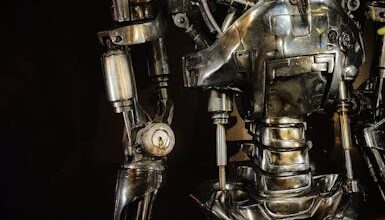The Promise and the Pain Point of Agentic AI

The world of artificial intelligence moves at a breathtaking pace, doesn’t it? One moment we’re marveling at a new language model, and the next, we’re talking about AI agents capable of complex, multi-step reasoning. This leap towards “agentic AI” promises a future where autonomous systems can manage projects, conduct research, and even navigate intricate business processes. It’s a vision that requires robust, reliable protocols, and for many in the AI community, Anthropic’s Model Context Protocol (MCP) emerged as a potential game-changer. It promised a standardized way for AI agents to interact, remember context, and collaborate effectively. But like many groundbreaking innovations, its initial release left a crucial piece of the puzzle wanting: the testing tools needed to truly harness its power.
Imagine building a skyscraper with revolutionary new materials, but only having a basic hammer to test its structural integrity. That’s a bit how developers felt. The promise was immense, but the practicalities of ensuring these complex AI systems worked as intended, consistently and reliably, were a significant hurdle. Enter a 24-year-old CTO with a vision, a deep understanding of developer pain points, and a willingness to challenge the status quo. His name is Marcelo Jimenez Rocabado, and his open-source project, MCPJam, isn’t just filling a gap; it’s actively reshaping the standard for AI server testing and proving that innovation can truly come from anywhere.
The Promise and the Pain Point of Agentic AI
Agentic AI isn’t just about large language models (LLMs) generating text; it’s about giving those models the ability to act. Think of an AI that can break down a goal into sub-tasks, use tools (like browsing the web or interacting with APIs), remember past actions, and learn from its failures to achieve a complex objective. It’s a fundamental shift, moving from static responses to dynamic, goal-oriented behavior.
Anthropic’s Model Context Protocol (MCP) was designed precisely to facilitate this. It offered a structured way for developers to manage the long-term memory and contextual understanding of these agents, addressing one of the biggest challenges in building sophisticated AI. By providing a clear framework for agents to access and update their “context,” MCP laid the groundwork for more intelligent, coherent, and persistent AI systems. It was an exciting development, signaling a new era for AI application development.
However, the initial tooling for testing these MCP-based agents was, to put it mildly, rudimentary. Anthropic offered an “MCP Inspector,” a useful starting point, but it was often slow, lacked collaborative features, and didn’t offer the robust capabilities that professional developers demand for complex system integration and testing. Building reliable agentic AI applications requires the same rigor as any other mission-critical software. You need to simulate scenarios, track context changes, debug interactions, and ensure consistent performance under various loads. Without adequate tools, the promise of MCP risked being bogged down in slow, frustrating development cycles.
Why Developer Tools Make All the Difference
In software development, the quality of your tools often dictates the quality and speed of your output. Imagine trying to build a modern web application without Git, integrated development environments (IDEs), or robust testing frameworks. It’s almost unthinkable. The same principle applies, perhaps even more so, to cutting-edge AI development. When you’re dealing with the unpredictable nature of AI and the complexity of agentic systems, powerful and intuitive testing tools aren’t a luxury; they’re an absolute necessity. The gap in MCP testing wasn’t just an inconvenience; it was a bottleneck for the entire ecosystem looking to build on Anthropic’s protocol.
The Fork in the Road: From Inspector to Innovator with MCPJam
This is where Marcelo Jimenez Rocabado enters the story. As a CTO working with AI, he saw the potential of MCP firsthand, but he also felt the sting of its testing limitations. Rather than waiting for a solution from the original creators, he leveraged the power of open source: he forked Anthropic’s MCP Inspector. For those less familiar, “forking” an open-source project means taking a copy of its source code to develop it independently, often to add new features, fix bugs, or adapt it for a different purpose.
Marcelo’s fork was not just a tweak; it was a fundamental reimagining. He set out to build MCPJam, an alternative designed from the ground up to be faster, more collaborative, and inherently more developer-friendly. He recognized that testing AI agents isn’t a solitary task; it often involves teams, requiring shared environments, reproducible tests, and efficient debugging flows.
MCPJam addresses the core frustrations head-on. It streamlines the testing process, making it significantly quicker to simulate agent interactions and observe context changes. More importantly, it brings collaboration to the forefront. Teams can now work together on testing scenarios, share insights, and accelerate the feedback loop crucial for iterating on AI agent behavior. This focus on speed and collaboration sets MCPJam apart, transforming what was a functional but limited inspector into a powerful, community-driven testing suite.
The Open-Source Advantage in a Rapidly Evolving Field
The choice to develop MCPJam as an open-source project is pivotal. In a field as dynamic as AI, open collaboration often outpaces proprietary development. An open-source project can benefit from contributions, feedback, and diverse perspectives from developers worldwide. This collective intelligence leads to faster innovation, more robust solutions, and a tool that truly serves the needs of its users because they are the ones building it, too.
MCPJam isn’t just a better tool; it’s a testament to the power of the open-source ethos. It shows that a nimble, community-backed initiative can identify and solve critical infrastructure gaps faster and often more effectively than even the largest AI players, especially when those players are focused on their core models and protocols.
MCPJam’s Impact: Shaping the Future of AI Testing Standards
The impact of MCPJam is already being felt across the AI development landscape. What started as a solution to a personal pain point has quickly evolved into a project backed by significant validation. Open Core Ventures, a firm known for investing in successful open-source projects, has thrown its weight behind MCPJam. This backing is a powerful endorsement, signaling that MCPJam isn’t just a niche tool but a critical piece of infrastructure poised to become an industry standard.
As developers increasingly adopt agentic AI for real-world applications—from customer service bots that remember past interactions to sophisticated data analysis agents—the need for reliable testing grows exponentially. MCPJam is stepping up to meet this demand, providing the confidence developers need to deploy complex AI systems into production environments. Its speed means faster iteration cycles, its collaborative features enhance team productivity, and its open-source nature fosters continuous improvement and adaptability.
Marcelo Jimenez Rocabado, at just 24, has not only built a vital tool but has also demonstrated a key principle of innovation: identify a genuine need, build a better mousetrap, and leverage the power of community. His work with MCPJam illustrates how agility, a keen understanding of developer workflows, and a commitment to open collaboration can indeed outpace even the biggest players in the AI arena. It’s a compelling reminder that the most significant advancements often emerge from the collective efforts of passionate individuals and communities, rather than solely from top-down directives.
A Testament to Agility and Open Collaboration
The story of MCPJam is more than just a tale about a new testing tool; it’s a narrative about the evolving landscape of AI development itself. It highlights the critical role of robust infrastructure and the immense power of the open-source community to drive innovation. In an era dominated by large tech giants, it’s refreshing to see a young CTO, backed by a growing community, take on a significant challenge left open by one of AI’s biggest names. Marcelo Jimenez Rocabado didn’t just find a workaround; he forged a new path, creating a tool that is now shaping the standard for AI server testing.
This success story reminds us that progress in AI isn’t just about groundbreaking models; it’s also about the unsung heroes building the crucial tooling that makes those models practical and reliable. MCPJam stands as a testament to the idea that with ingenuity, collaboration, and a deep understanding of user needs, even a 24-year-old can redefine an industry standard and accelerate the entire ecosystem towards a more robust, agentic AI future. The fork that created MCPJam isn’t just code; it’s a statement about the future of AI development.





